Encino residents weren’t happy in the early 1990s about a planned shopping center at Hayvenhurst Avenue and Ventura Boulevard. They were even less happy when the developer went bankrupt after digging up the contaminated soil at the site, a former gas station, leaving behind a deep crater that filled with water.
Rick Caruso, then a real estate rookie, took over the site, derisively nicknamed “Lake Hayvenhurst,” and proceeded with a strategy he would deploy many times in the future: wooing the locals, spending lavishly to move the project forward.
He asked residents of the affluent Los Angeles community to offer suggestions for his retail center’s design and ambiance, even hiring a shuttle bus to take them to a tree farm to allow them to select varieties for the development.
What neighbors had wanted at their mall “was really just simple stuff in my opinion,” he told Los Angeles Magazine years later, “and we got 100% support.”
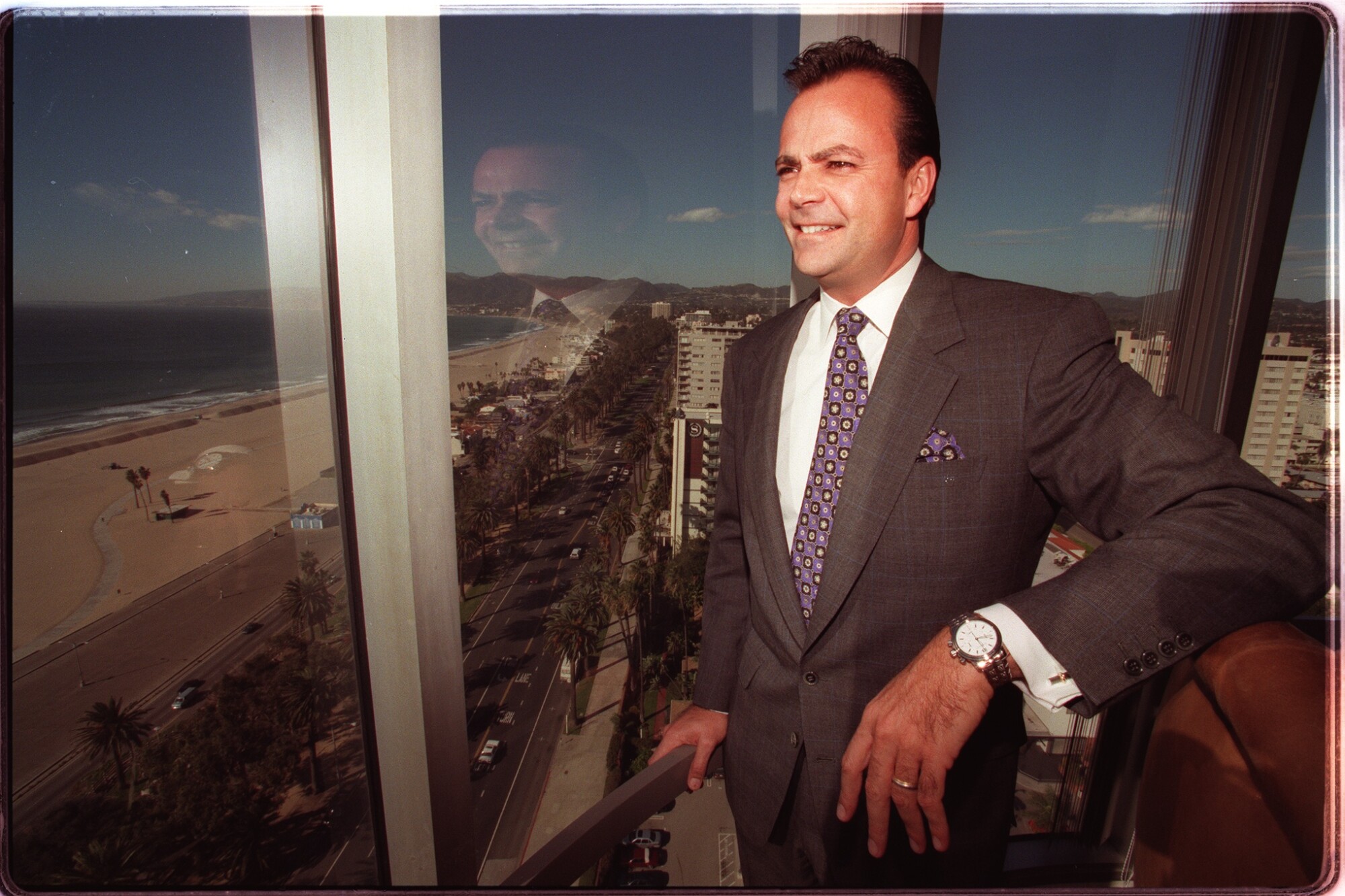
Caruso in 1997, at his corner office on the 14th floor at 100 Wilshire Blvd. in Santa Monica.
(Bob Carey / Los Angeles Times)
Encino Marketplace, as he called it, was a step up from a typical neighborhood shopping center of the time. It had its grocery store and drugstore, but Caruso dressed up the place with arches, cupolas and patios. People came to linger by a burbling fountain outside of Starbucks.
At the center’s 1994 grand opening, Caruso arranged appearances by TV stars John Goodman and Phil Hartman. He invited a crowd of community residents to a fancy celebratory dinner.
Over the ensuing decades, Caruso forged a career as one of Los Angeles’ most prominent real estate developers and retail operators by finding the sweet spot between what the neighbors want and what he is willing to build.
“There are people who woke up on third and thought they hit a triple. I think Rick woke up on third and stole home.”
— David Greensfelder, Bay Area real estate consultant
That approach has enabled him to construct some of the region’s most popular shopping centers while bringing him a sizable fortune — estimated by Forbes at $4.3 billion — that has propelled his mayoral ambitions. In the mayoral race, Caruso, whose father founded Dollar Rent a Car, appears to be in a dead heat with Rep. Karen Bass (D-Los Angeles), thanks in part to his spending of more than $33 million in personal funds.
The Caruso real estate kingdom encompasses nine retail centers, of which the best known are the Grove in the Fairfax district of Los Angeles and the Americana at Brand in Glendale. He also owns high-end apartments, a historic high-rise office building in Glendale and an upscale beach resort in Montecito. Two more residential projects, in Thousand Oaks and L.A.’s Beverly Grove neighborhood, are planned.
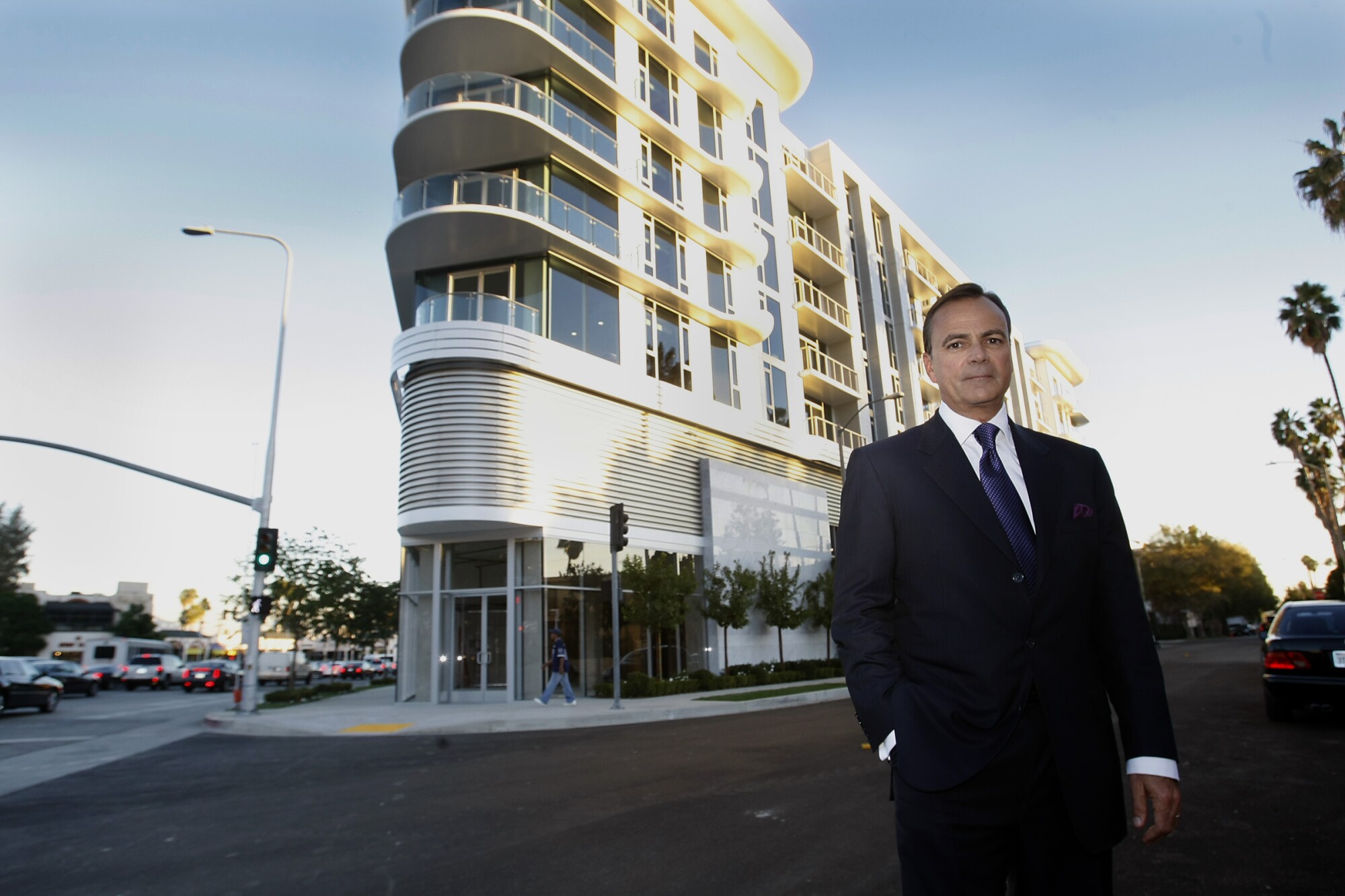
Caruso in 2012, in front of a $60-million apartment and retail complex near the Beverly Center.
(Kirk McKoy / Los Angeles Times)
A look at the origins and operations of that empire shows a businessman who has deployed his political instincts, force of personality and sizable resources to sway constituencies in his favor. Caruso’s intense focus on design and white-glove operation have set him apart from many in his industry and turned him into perhaps the best-known real estate developer in Southern California.
Another key distinction: Caruso doesn’t partner with investors, putting up his own money to launch his luxe developments, which he never sells. Both are unusual approaches central to creating his corporate dynasty and personal wealth.
Caruso’s wealthy father helped him start his business by agreeing to lease parking lots for Dollar that the young Caruso, then a fledgling real estate lawyer, was able to acquire by showing lenders that his father’s business would be the tenant. Selling lots after they rose in value gave him the funding to build more.
“There are people who woke up on third and thought they hit a triple,” Bay Area real estate consultant David Greensfelder said. “I think Rick woke up on third and stole home.”
Caruso declined to be interviewed for this report.
It’s easy to see the origins of Caruso’s hands-on approach and style of manicured outdoor centers where visitors are enticed to hang out.
After his “Lake Hayvenhurst” success, Caruso acquired another failed mall development site, in Thousand Oaks off the Ventura Freeway at Westlake Boulevard. That proposed center was doomed because neighbors thought it too tall and too dense.
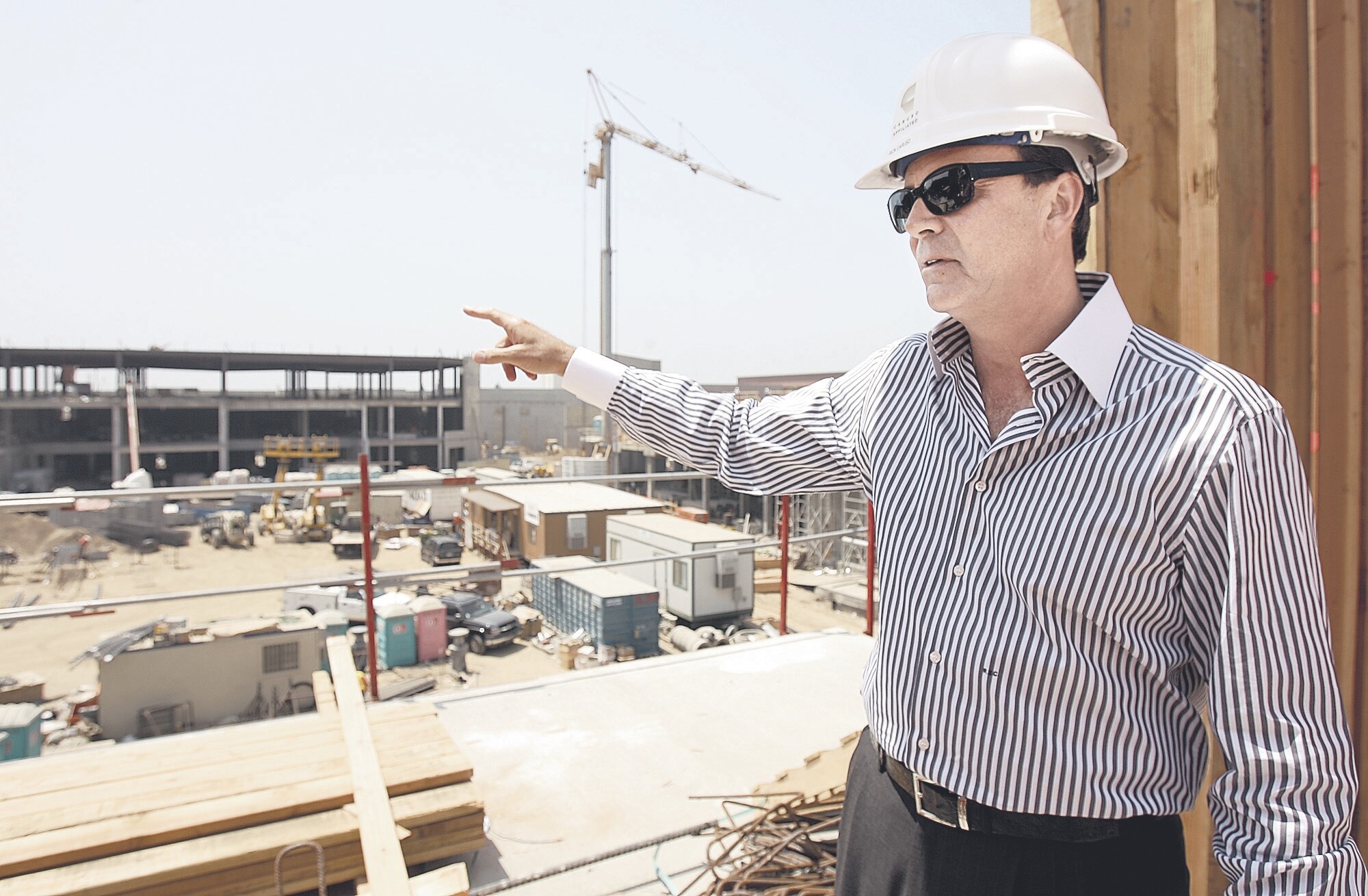
Caruso inspects the building site of the Americana at Brand in Glendale.
(Tammy Abbott / News-Press)
Caruso set out to discover at public meetings what they would support. When they mentioned such coveted retailers as Bristol Farms and Barnes & Noble, which Caruso didn’t yet have the clout to attract, he enlisted the community to lobby the store operators on his behalf.
“He brought us along, and we were part of the project,” said Cathy Schutz, who was president of a local homeowners’ group and spoke with representatives of Barnes & Noble in support of Caruso.
“He started out on the right foot, and people could see what his vision was,” she said. “He was able to tell us about it and put it into actual practice.”
In developing that outdoor mall — dubbed the Promenade at Westlake — he laid on deluxe details that other developers tended to consider too costly: lanterns made by craftsmen in Mexico, hand-quarried paving stones and custom-made fountains. He used different materials and colors on individual storefronts to try to create the look of a place that was built over time, a practice he employed at future projects, including the Grove and Americana.
Caruso’s notion of a community center where people could shop, eat, see a movie or merely pass the time garnered a design award from the International Council of Shopping Centers — and inspired imitators in Thousand Oaks, Schutz said.
Caruso replicated that style in 1998 in Calabasas, this time with a Mediterranean theme and a man-made lake. The outdoor Commons at Calabasas retail, dining and entertainment complex became a tourist attraction for people hoping to catch a glimpse of local celebrities such as Kim Kardashian. Its success prepared the way for Caruso’s breakthrough development, the Grove, in 2002.
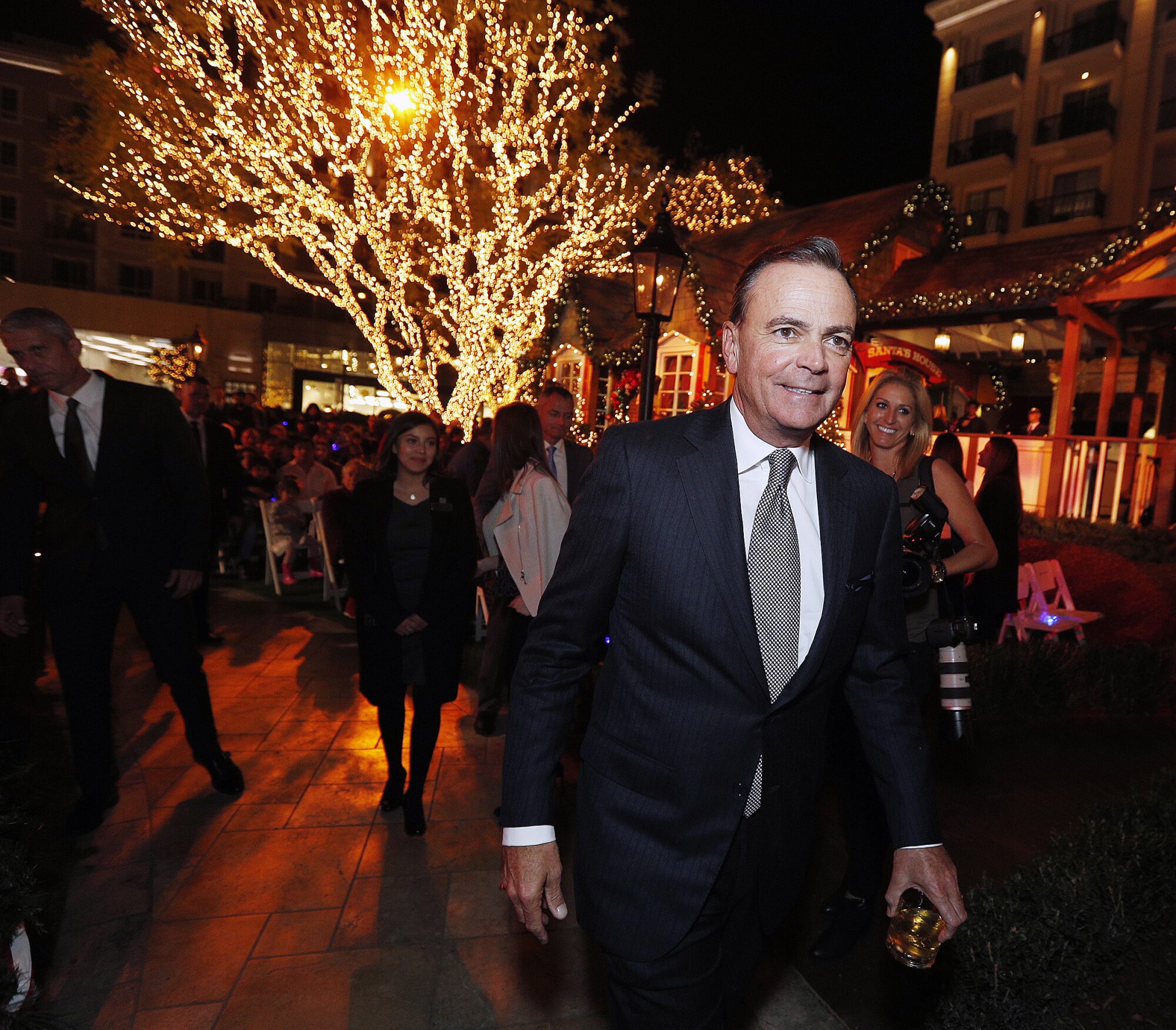
Caruso arrives at the 2017 Christmas tree lighting at the Americana at Brand.
(Tim Berger / Burbank Leader)
Architecture critics were scornful of what Caruso wrought next to the historic Farmers Market in L.A.’s Fairfax district. To then-L.A. Times architecture critic Nicolai Ouroussoff, it looked like a pretend city from an animated Disney film.
“With their faux public streets, cut off from the surrounding cityscape and cloaked in a veneer of nostalgia, projects such as the Grove contribute nothing of value to the public realm,” Ouroussoff wrote.
The Disney aura was hardly inadvertent. The Grove unapologetically evokes the Main Street U.S.A. entrance to Disneyland; a trolley on tracks traversing the project was designed by a former Disney Imagineer.
Caruso is obsessed with the details of his projects; he even personally selected which types of flowers would be planted at the Grove. He spends lavishly on water features, concierges, cleanup crews and other elements that give his properties a premium sensibility that contributes to their financial success, said Andrew Turf of the commercial real estate firm CBRE: “It’s not that he has retailers that don’t exist elsewhere; it’s customer experience and the pursuit of detail that he’s known for that sets him apart.”
Like a blockbuster movie sniffed at by critics, the $160-million Grove lured a large audience. The Grove became one of the region’s top attractions, with about 20 million visitors in the immediate pre-pandemic years, edging out Disneyland itself.
“I don’t have investors. I get the freedom to make decisions I think are best.”
— Rick Caruso
Caruso’s skill at creating landscapes that keep visitors on the premises for hours, spending money, is admired by retail experts and competitors alike.
“What the Grove and Americana have done especially well is create these environments that are fun to hang out in and attract a ton of foot traffic,” said Vince Tibone, head of the retail and industrial research group at the commercial real estate analytics firm Green Street. “That ultimately leads to very, very strong sales.”
Because Caruso’s firm is private, Green Street hasn’t compiled sales figures for the tenants in those malls, but the firm assigns them its A++ designation, awarded to the top 3% or 4% of the malls in the country. The sales per square foot that Caruso’s firm claims for the Grove would place it second among U.S. retail malls, behind only the Bal Harbour Shops near Miami, according to a 2015 estimate by Green Street.
Caruso’s studied awareness of shoppers’ appetites has helped him tailor his projects to local desires, said competitor Joel Mayer, who specializes in converting struggling shopping centers to other uses for Los Angeles developer Lowe.
“Rick is extraordinary at reading the market and the consumer in the area that he is building something,” Mayer said. His properties “are appropriate for wherever they are.”
One issue raised by Caruso-style retail centers, especially in light of his run for Los Angeles mayor, is their functional relationships with their neighbors.
“He builds environments that people plainly like to be in,” observed urban planning expert Michael Manville of UCLA’s Luskin School of Public Affairs. “Like many malls, they hearken back to an era of city-building that a lot of urban designers like — there’s plenty of space for walking, they’re quiet, and they have a built environment of minimal setbacks, buildings right next to one another and stimulating things to look at as you walk along. These are the hallmarks of successful urban shopping districts in the pre-automobile era, and people will drive from all over the place to go and spend time there.”
But, he added, these “islands of good urban design that themselves depend heavily on good automobile access … they’re built to be driven to, so they’re often surrounded by vast quantities of parking, and that is bad urban planning in many ways.” From the inside, “this is a very nice urban environment, but from the outside, it’s not.”
Pedestrians on the Grove Drive, which abuts the mall’s eastern boundary, might feel themselves virtually shouldered off its narrow sidewalk by the mall’s flat, almost featureless exterior wall.
“It’s very hostile to that street,” Manville said. “So one question is, what would a Mayor Rick Caruso bring to the public realm? Would he bring what he has tried to do within his properties, or would he bring what his properties suggest to the city from the outside?”
Nothing but politics necessarily prevents the city of Los Angeles from creating walkable, alluring retail zones — Santa Monica has done so on its 3rd Street Promenade, and L.A.’s Larchmont Village offers something of the same homey, intimate shopping experience.
Caruso attempted to address such criticism at Glendale’s Americana, with more street-side storefronts and open pedestrian entrances. But the mall remains inwardly focused on its shopping boulevards and central courtyard, where visitors lounge on benches and lush grass beside Caruso’s signature dancing fountains.
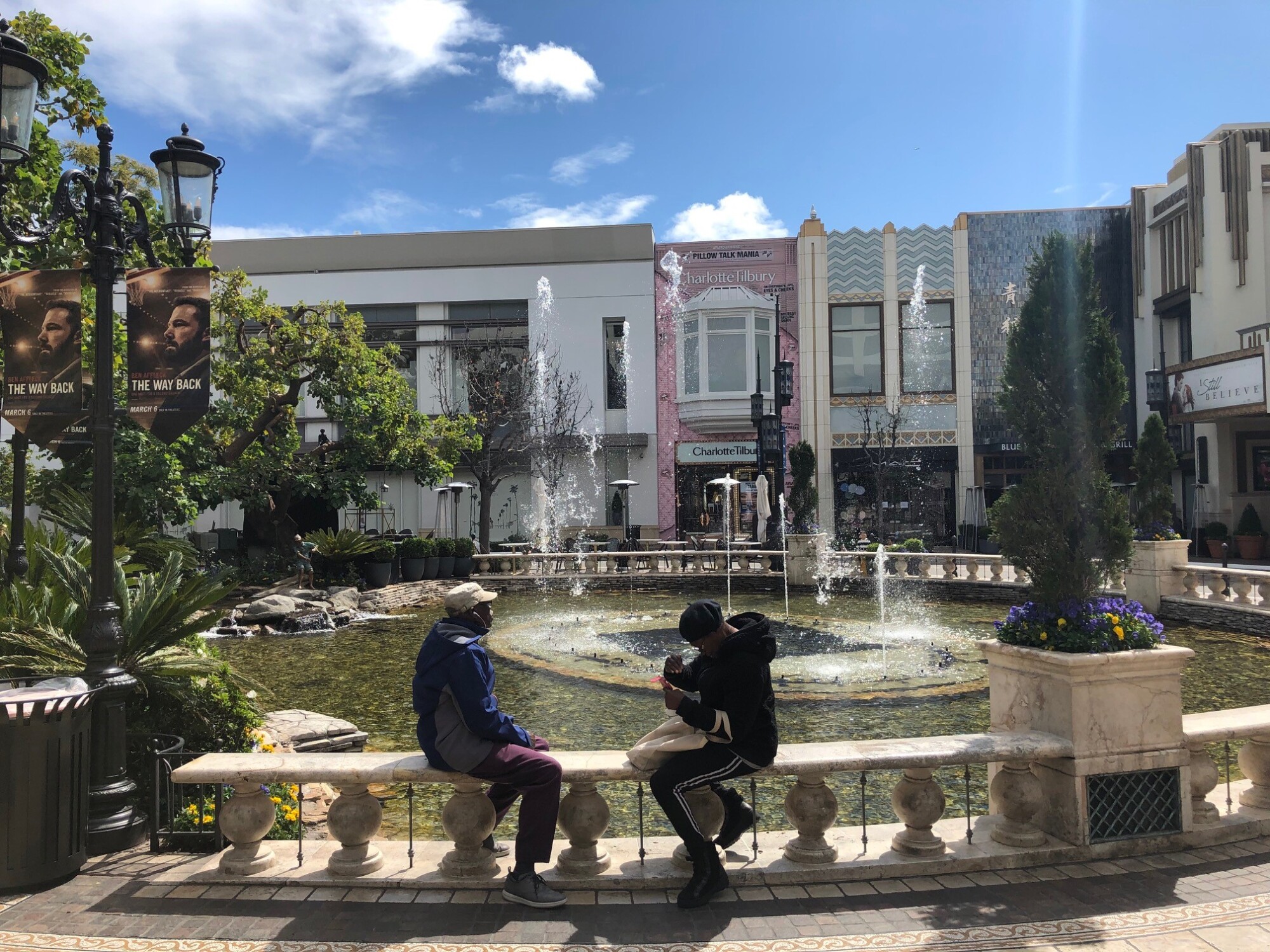
Fountains are a staple at Caruso’s shopping centers, including the Grove.
(Christopher Reynolds / Los Angeles Times)
Some of Caruso’s retail malls project an exclusionary air, whether through their pricey stores and ritzy feel or the potentially high cost of parking. Many shoppers get free parking with a validation from certain stores and restaurants at the Grove, Americana and Palisades Village, but those who dawdle too long or don’t spend at least $250 could pay as much as $30 at the Grove.
“The biggest fault I would give Rick is that wherever he goes, it’s very much his kind of place,” Greensfelder said, and may not feel welcoming to everyone. Palisades Village, he observed, “is objectively lovely” but “built for the few, not the many. It’s not necessarily for the entire community.”
Caruso insists that his centers have broad appeal, pointing to some food offerings at low price points and the sheer volume of visitors who keep coming back. At the Americana, 29% of guests visit more than once a week, the company says.
His malls and apartments are resolutely upscale, with residential units renting for up to five figures per month. The apartments are devoid of below-market affordable units, which were not considered a priority by city officials at the time they were built, the company said. Developers often agree to set aside units for lower-income people in exchange for constructing bigger buildings than codes allow.
“When he had to have negotiations with us, he showed up in person,” recalled Dick Platkin, a housing expert who was on the board of the Beverly Wilshire Homes Assn. in 2016-17, when it opposed Caruso’s plans for an upscale high-rise apartment building at 333 S. La Cienega Blvd., just south of the Beverly Center shopping mall. “He didn’t send one of his underlings.”
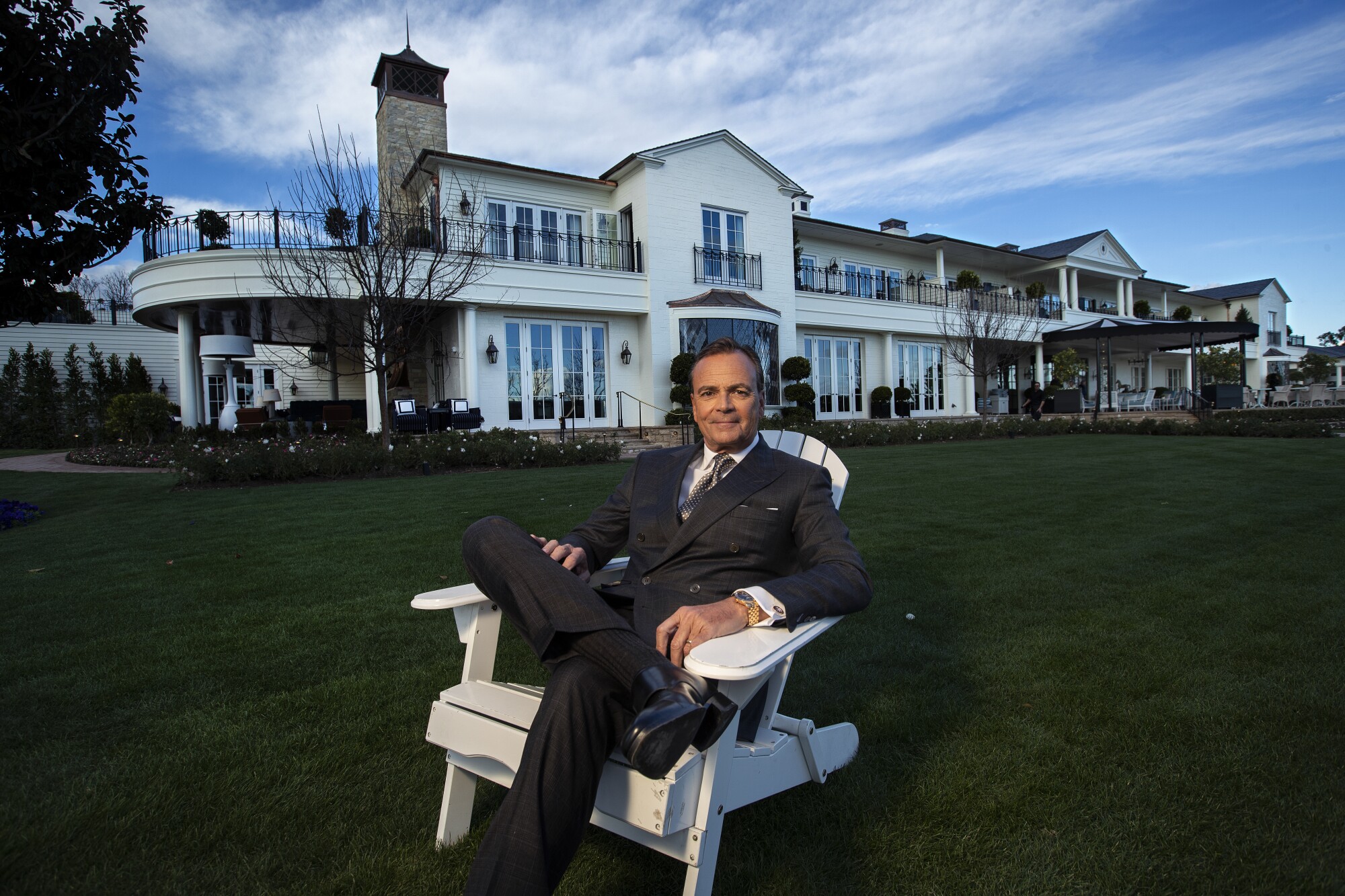
Caruso in 2019 in front of the Manor House at his Rosewood Miramar Beach resort in Montecito.
(Los Angeles Times)
Caruso offered local community and tenants groups that might challenge the project hundreds of thousands of dollars in contributions in return for their support — and he got their support, said Platkin, a former L.A. city planner.
Caruso needed their support because the project’s 185-foot height vastly exceeded the site’s zoning limit, necessitating planning waivers. He ultimately received them.
The project remains unbuilt, but it is still planned as a 145-unit luxury and retail development, with 10% of the apartments designated as affordable housing. Construction will start when the apartment market gets strong enough to support it, Caruso company executive Corinne Verdery said in February.
Caruso has said the company won’t pursue other new real estate developments in the city of Los Angeles if he is elected mayor. His firm would be operated as a blind trust headed by Verdery.
Caruso’s expenditures haven’t gone only toward community groups. In the five years through 2016, when he was angling for approval for the La Cienega project, he and affiliated donors contributed more than $476,000 to the city’s elected officials and their initiatives, according to contribution reports reviewed by The Times.
In that time frame, he made campaign contributions to almost every one of the city’s 17 elected officials. His charitable foundation provided $125,000 to a nonprofit set up by Mayor Eric Garcetti. And his companies gave $200,000 to the successful campaign for Measure M, a sales tax hike for transit projects that Garcetti championed in 2016.
City records show that Caruso made no further contributions in city politics from then until this year, when he has contributed only to his own mayoral campaign.
Many developers need to unload their projects to pay off investors after a property is settled and thriving. Like the mall-owning giants and some regional players such as Irvine Co., Caruso doesn’t sell the properties he builds, because he has no investors who want their money back.
Holding on to projects, which he’s done since the beginning, has allowed Caruso to accumulate wealth as his portfolio has grown and to reap the benefits of being a landlord.
The real estate tycoon typically gets construction loans for 65% to 70% of the cost to build his projects, the company said. When the complexes are up and running, he reduces the debt load by paying off the construction loans with long-term commercial financing that leaves the properties 40% to 45% indebted — considered low in the industry.
Because he has no partners sharing ownership in his projects or his company, Caruso has free rein to build what he likes.
At the 2019 opening of his extravagant Rosewood Miramar Beach resort in Montecito, where pricey design flourishes could be seen in all directions — a Brazilian walnut deck at the seaside bar, hand-painted wallpaper and custom-designed Baccarat crystal chandeliers in the ballroom — Caruso told The Times he builds that way because he can.
“I don’t have investors,” he said. “I get the freedom to make decisions I think are best.”
Crucial to his success was that early assist from his father — who turned a single car dealership bought after returning from World War II into the nation’s fourth-largest rental car company when it was sold to Chrysler Corp. in 1990.
The practice Caruso started with his father, Hank, who died in 2017, of buying property around U.S. airports to lease to car rental companies expanded beyond Dollar to include other companies, such as Enterprise Rent-A-Car and Budget Rent a Car. The lots increased in value, and he gradually sold most of them to fund development of his retail centers.
His company said that for the last 30 years, it has had a compound annual growth rate of 18% — a high rate of return on investment. Caruso has said he intends his company to be “dynastic” and not sold in the future.
The most intense opposition Caruso’s retail projects receive tends to come from nearby business owners fearful that the new developments will siphon off their customers. Those battles highlight the Caruso way of doing business.
In building the Americana at Brand shopping center in Glendale, Caruso faced opposition from the nearby Glendale Galleria.
(Mel Melcon / Los Angeles Times)
The owner of the Glendale Galleria, General Growth Properties, spent years trying to block Caruso’s Americana at Brand, a $400-million development that was slated to rise next door to the older mall.
After the Glendale City Council approved the Americana, General Growth managed to place a referendum on the city’s 2004 ballot to overturn the decision. The referendum failed, but the feud wasn’t over.
The two companies traded lawsuits over their competitive tactics, with Caruso ultimately extracting a $48-million settlement of a suit over General’s effort to prevent the Cheesecake Factory from opening a branch in the Americana.
Even after the opening of the Americana, Caruso was willing to keep spending to develop the property to his liking. His target was one of the Galleria’s anchor tenants, the upscale department store Nordstrom, and he was unrelenting in his efforts to woo it.
To make the Nordstrom deal happen, Caruso first had to get rid of the three-story Golden Key Hotel. Owner Ray Patel had refused to sell to clear the way for construction of the Americana, so Caruso had built on three sides of the inn. And that spot was where Caruso wanted to put Nordstrom.
Patel again refused to sell to Caruso, turning down a $6-million offer, and was fighting Glendale’s push to use eminent domain to force a sale, leading more than 40 marchers who chanted “Let Ray stay” in front of Glendale City Hall. Patel was persuaded by a $16.5-million offer for the hotel.
Then, to accomplish the tenant coup, Caruso pulled off a move deemed extremely unusual by real estate experts at the time: He bought Nordstrom’s Galleria building from the Seattle retailer, making Caruso part owner of the rival Galleria. Although most of the Galleria is owned by General Growth Properties, Nordstrom owned its own building, as is common for major department stores.
The once-bitter antagonists made peace, assisted by Caruso’s promise to help pay for improvements to the aging Galleria. Nordstrom moved to the Americana in 2013, with Dick’s Sporting Goods eventually taking its Galleria spot. And the Galleria ended up with an arguably more upscale merchant, Bloomingdale’s.
Reflecting on the long-running fight in which he spent tens of millions of dollars and got what he wanted, Caruso told The Times in 2011: “The past is the past.”

